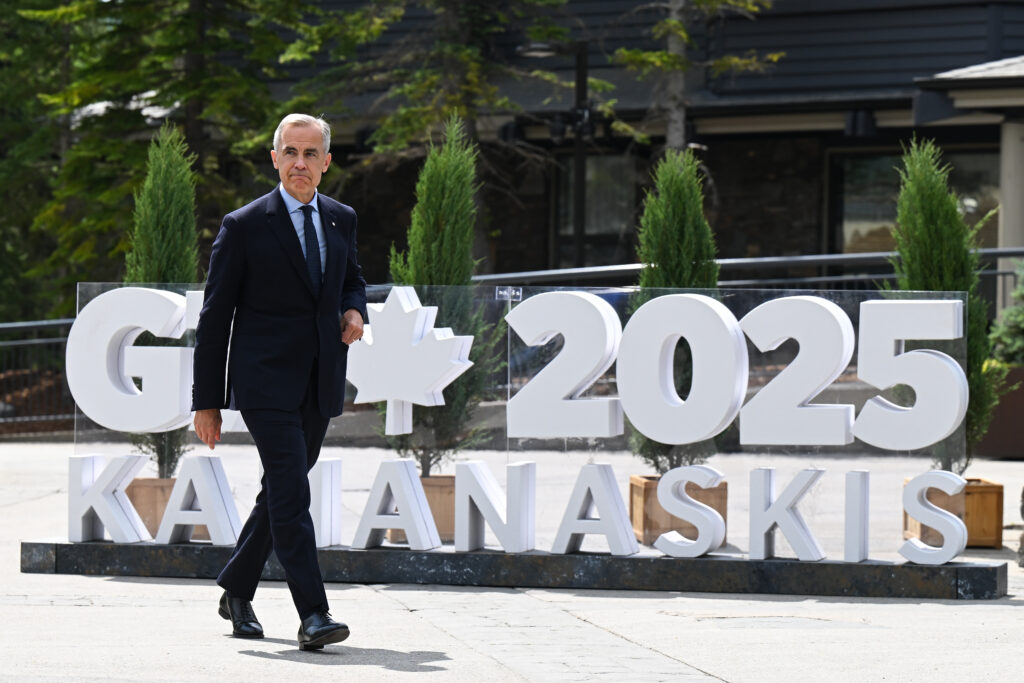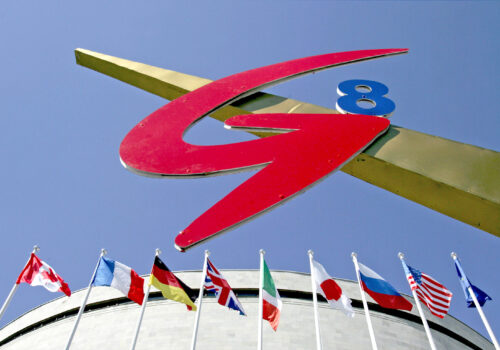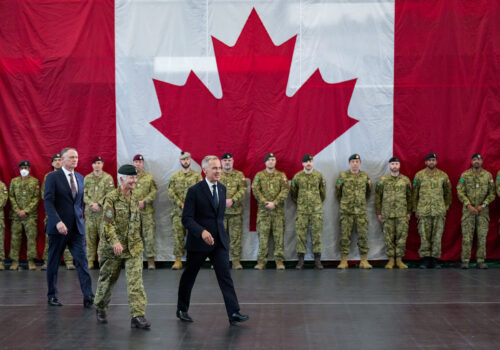What didn’t happen sometimes matters more than what did. On Tuesday afternoon, the Group of Seven (G7) summit in Alberta, Canada, concluded, but US President Donald Trump had left the day before, jetting back to Washington as the war between Israel and Iran intensified. Trump’s attendance for the full two-day summit was not the only thing that didn’t go as planned—several expected meetings and outcomes were canceled as well. Below, Atlantic Council experts examine four things that did not happen and what each nonevent reveals about the relevant issue.
1. The G7 did not release a joint communiqué
The absence of a joint communiqué at this week’s G7 summit starkly illustrates the deepening policy divisions among leaders of the world’s most powerful economies. While policymakers debate what the G7 can accomplish amid growing US-European tensions, a more fundamental question has emerged: Is the G7 itself equipped to address today’s complex geopolitical landscape?
The summit exposed significant rifts between G7 members and the United States on critical international issues. Trump’s assertion that ejecting Russia from the former Group of Eight (G8) was a strategic mistake amplified tensions over Russia’s war in Ukraine. While the G7 did endorse a statement calling for “de-escalation of hostilities, including a ceasefire in Gaza,” watered down statements like this underscore the challenges in achieving consensus. These parallel conflicts reveal not only internal G7 divisions but also the growing disconnect between G7 positions and broader global sentiment, especially when it comes to Israel and Gaza.
The lead-up to the Kananaskis summit highlighted another critical question: Can the G7 remain relevant while excluding major global players? Pressure from G7 leaders ultimately compelled Canadian Prime Minister Mark Carney to extend an invitation to Indian Prime Minister Narendra Modi, despite ongoing diplomatic tensions over last year’s killing of a Khalistani separatist in British Columbia. This last-minute inclusion underscores an emerging reality—as one of the world’s largest economies, a crucial node in global supply chains, and a key player in Indo-Pacific security, India’s absence from major G7 discussions would render many outcomes meaningless.
Perhaps most troubling is the weakening of the shared democratic values that supposedly bind the G7 together. The transatlantic relationship faces unprecedented strain as the Republican Party, under the leadership of Trump and Vice President JD Vance, increasingly views liberal European societies through a harsh cultural lens. While the United States frames China as the primary geopolitical challenge of its time, today’s Republican Party often sees European societies as equally divergent from American values and interests. This ideological drift threatens the very foundation upon which the G7 was built.
These developments raise existential questions about the G7’s future relevance. A forum designed for the world’s democratic economic powerhouses now struggles to produce basic agreements, while excluding nations essential to global stability and prosperity. Today, the G7 risks becoming an increasingly irrelevant talking shop, much like the United Nations Security Council, unable to address many of the defining challenges of the twenty-first century.
—Rachel Rizzo is a nonresident senior fellow at the Atlantic Council’s Europe Center.
***
Trouble was brewing even before Trump’s early departure from the leaders’ summit on Monday evening and the absence of a communiqué on Tuesday. Trump’s trade policy had already effectively resulted in a G6+1—a coalesced European, Canadian, and Japanese front against the United States. But the fracture in the G7 has only become more evident this week. At the time of its formation fifty years ago, the group was created as a channel for economic coordination between the world’s largest economies. In recent years, the conflict between Ukraine and Russia had energized the G7, which had functioned as the hub for sanctions coordination and strategizing on supporting Ukraine. This energizing, and in some ways defining, achievement of the G7 in the past decade was put into question by Trump’s assertion on Monday that Russia should be brought back into the G8 fold, laying bare the misalignment between him and the other leaders.
There are issues that could have possibly aligned G7 leaders, such as responding to Chinese economic influence, including Beijing’s manufacturing overcapacity. But what ultimately binds the group and makes it different from the Group of Twenty (G20) and the United Nations Security Council is broad agreement on democratic values, free and open markets, and a belief in working together with allies. A fracturing G7 puts these foundational tenets under scrutiny. Trump’s early departure also snubbed partners beyond the G7; India and Mexico were looking forward to their respective bilateral meetings that could have furthered trade negotiations.
It’s clear that on its fiftieth anniversary, the G7 is in the middle of a geopolitical crisis, as the Israel-Iran conflict plays out, and an existential crisis, exacerbated by the United States’ strained relationship with the rest of the group. What lies ahead as France will take on the presidency in 2026, and whether the G6+1 break will continue, depends on how much value Washington sees in collaborating with its closest allies on economic issues.
—Ananya Kumar is the deputy director for future of money at the GeoEconomics Center.
2. Trump did not meet with Ukraine’s president
Trump did himself no favors at the G7 Summit toward his goal of achieving a durable peace in Ukraine. Trump has set out a tough approach to achieve that peace. He has asked for serious concessions from both Ukraine and Russia and said that he would exert pressure on the side(s) blocking progress. Since then, Ukraine has accepted every proposal Trump has offered since mid-March, and Russia has rejected them all except for one that it violated immediately. It is clear which side is obstructionist.
Trump had an excellent chance to use the G7 Summit to put needed pressure on the Kremlin. The G7 was poised to lower the price cap for a barrel of Russian oil from sixty dollars to forty-five dollars, which would put pressure on the Russian oil revenues enabling its aggression in Ukraine. But the United States vetoed the proposal last week—Trump’s first gift to Russian President Vladimir Putin at this G7 Summit.
The second gift came after his arrival in Canada. The US president repeated his criticism of the G7 for kicking Russia out of the group because of its conquest and “annexation” of Crimea in 2014. (Trump had done the same in his first term.) Since Putin is blocking his peace efforts, why would Trump provide this offering to the Russian dictator at this time? It is also true that by departing the summit early to deal with the ongoing crisis in the Middle East, Trump missed a planned side meeting with Ukrainian President Volodymyr Zelenskyy. No harm, no foul there, but achieving a real peace in Ukraine will remain a distant wish if the White House continues to treat the aggressor to bouquets.
—John E. Herbst is the senior director of the Atlantic Council’s Eurasia Center and a former US ambassador to Ukraine.
3. Trump did not meet with Mexico’s president
After much anticipation, the first face-to-face meeting between Trump and Mexican President Claudia Sheinbaum did not take place due to the US president’s early departure. Perhaps unexpectedly, the leaders have had an amicable and constructive relationship so far, with mutual praise often being shared between the two and at least seven phone calls taking place since Trump’s election in 2024.
The meeting in Kananaskis, however, would have offered neutral ground for both leaders to further discuss the actions Sheinbaum has taken to address US security concerns while also addressing the thornier aspects of the bilateral relationship. This includes Mexico’s refusal to accept the involvement of US troops in its strategy against the illegal drug trade and cartels. It also includes Mexico’s concern about a proposed 3.5 percent tax on remittances currently moving through the US Senate. (Remittances to Mexico represent roughly 3.7 percent of the country’s gross domestic product.)
A three amigos-style meeting of Trump, Sheinbaum, and Carney was off the table even before the summit. But the presence of all three newly minted North American leaders and their confirmed bilateral meetings on the sidelines of the G7 Summit had nonetheless raised hopes across the region that a tangible agenda to discuss next steps for the United States-Mexico-Canada Agreement (USMCA) would be set. Now, just over a year before the sunset clause is activated in July 2026, the private sector across all three countries will be left craving certainty about the future of the trade deal, especially against the current backdrop of continuously changing trade conditions and recently doubled steel and aluminum tariffs.
So what comes next? US-Mexico communication lines remain open. Mexico has an ally in Christopher Landau, a US deputy secretary of state and a former US ambassador to Mexico who met with Sheinbaum last week. The United States should now continue to signal its willingness to engage with Mexico to find solutions to shared challenges by setting a date for Secretary of State Marco Rubio’s announced visit and pave the way for a Trump–Sheinbaum tête-à-tête.
—Valeria Villarreal is a program assistant at the Atlantic Council’s Adrienne Arsht Latin America Center.
4. No momentum was generated going into the NATO Summit
The G7 presents two cautionary tales for next week’s NATO Summit in The Hague. First, if Zelenskyy’s presence at the G7 contributed to Trump’s early departure, then this would serve as a reminder for NATO allies to tread lightly on signaling too much support for Ukraine in The Hague at the risk of alienating the US administration. Second, Trump’s comments in Canada suggesting that Russia should rejoin the G8 are also a warning to NATO. While allied leaders were already unlikely to raise costs on Russia at the summit for its ongoing war in Ukraine, Trump’s comments highlight that even tough language on Russia in the expected summit communiqué could exacerbate tensions while Trump is in The Hague.
Ignoring the threats Russia poses to the Alliance and the importance of maintaining support for Ukraine comes with different (and I would argue more problematic) risks. But if NATO’s goal in The Hague is to project Alliance unity and avoid a dust-up with Trump, then the Alliance should stay focused on securing a new defense spending pledge and go home. All the hard work, for better or for worse, will fall after the summit.
—Torrey Taussig is the director of and a senior fellow at the Transatlantic Security Initiative in the Atlantic Council’s Scowcroft Center for Strategy and Security. Previously, she was a director for European affairs on the National Security Council.
Further reading
Fri, Feb 28, 2025
To rejoin the G7, Russia should meet several important conditions
New Atlanticist By
To rejoin the G7, Russia must meet strict conditions, including making significant concessions for a just and lasting peace in Ukraine.
Thu, Jun 12, 2025
Seven charts that will define Canada’s G7 Summit
New Atlanticist By
Our experts provide a look inside the numbers that will frame the high-stakes gathering of Group of Seven leaders in Alberta.
Wed, Jun 11, 2025
Carney’s ‘hinge moment’ is about more than just Canadian defense spending. What does that mean for Washington?
New Atlanticist By Imran Bayoumi
The Canadian prime minister gave his first major defense and security speech on June 9, describing an unraveling international order and an increasingly unreliable United States.
Image: Prime Minister of Canada Mark Carney arrives during the welcome for Outreach partners at the G7 Leaders' Summit in Kananaskis, Alberta, Canada, Tuesday, June 17, 2025. (AAP Image/Lukas Coch) REUTERS




